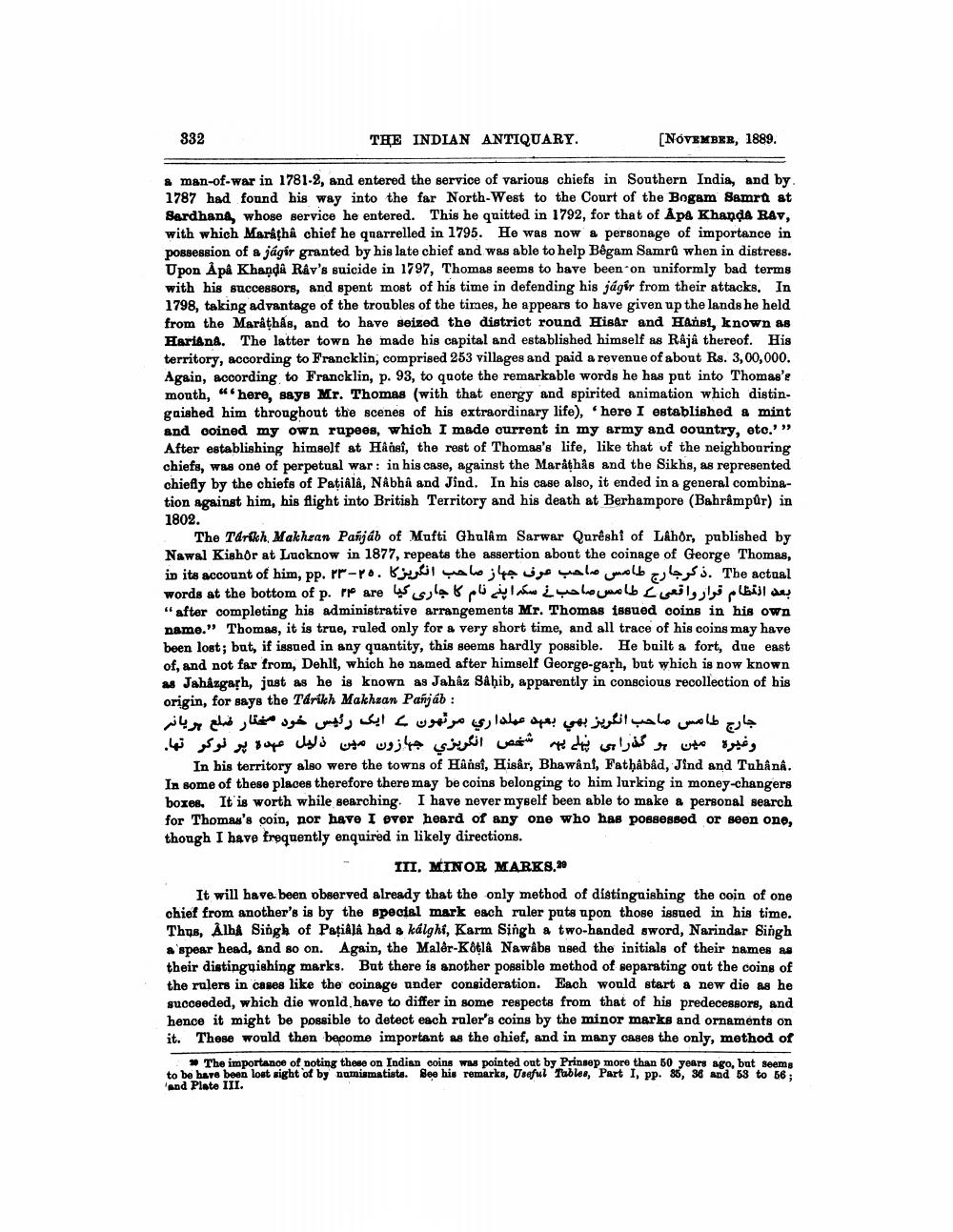________________
332
THE INDIAN ANTIQUARY.
[NÓVEMBER, 1889.
& man-of-war in 1781-2, and entered the service of various chiefs in Southern India, and by 1787 had found his way into the far North-West to the Court of the Bogam Samro at Sardhana, whose service he entered. This he quitted in 1792, for that of Apa Khanda Rav, with which Marathả chief he qnarrelled in 1795. He was now a personage of importance in possession of a jágir granted by his late chief and was able to help Begam Samrû when in distress. Upon Åpå Khanda Râr's suicide in 1797, Thomas seems to have been on uniformly bad terms with his successors, and spent most of his time in defending his jágir from their attacks. In 1798, taking advantage of the troubles of the times, he appears to have given up the lands he held from the Marathås, and to have seized the district round Hisar and Hansi, known as Hariana. The latter town he made his capital and established himself as Rajâ thereof. His territory, according to Francklin, comprised 253 villages and paid a revenue of about Rs. 3,00,000. Again, according to Francklin, p. 93, to quote the remarkable words he has put into Thomas's mouth, “here, says Mr. Thomas (with that energy and spirited animation which distingaished him throughout the scenes of his extraordinary life), here I established & mint and coined my own rupees, which I made current in my army and country, eto.'» After establishing himself at Hânsi, the rest of Thomas's life, like that of the neighbouring chiefs, was one of perpetual war: in his case, against the Maråthås and the Sikhs, as represented chiefly by the chiefs of Patiala, NÅbha and Jind. In his case also, it ended in a general combination against him, his flight into British Territory and his death at Berhampore (Bahrampur) in 1802.
The Tarikh Makhzan Panjáb of Mufti Ghulam Sarwar Qureshi of Lahor, published by Nawal Kishor at Lucknow in 1877, repeats the assertion about the coinage of George Thomas, in its account of him, pp. rr-ro. Byli valo; ha uigi yale molbu ss. The actual words at the bottom of p. rr are usb pula ialomel zweilyll " after completing his administrative arrangements Mr. Thomas issued coins in his own name." Thomas, it is true, ruled only for a very short time, and all trace of his coins may have been lost; but, if issued in any quantity, this seems hardly possible. He built a fort, due east of, and not far from, Dehll, which he named after himself George-garh, but which is now known as Jaházgarh, just as he is known as Jaház Sahib, apparently in conscious recollection of his origin, for says the Tarikh Makhaan Panjab :
خود مختار ضلع ہریانہ جارج طامس صاحب انگریز بهي بعد عملداري مرنهون کے ایک رئیس
تها. انگريزي جهازون مين دليل عهده پر نوکر
شخص ہو گذرا ہی پہلے پہر وغيره مین
In his territory also were the towns of Hånsi, Hisar, Bhawani, Fathåbåd, Jind and Tuhana. In some of these places therefore there may be coins belonging to him lurking in money-changers boxes. It is worth while searching. I have never myself been able to make a personal search for Thomas's coin, nor have I ever heard of any one who has possessed or seen one, though I have frequently enquired in likely directions.
III. MINOR MARKS.29 It will have been observed already that the only method of distinguishing the coin of one chief from another's is by the special mark each ruler puts upon those issued in his time. Thus, Alhi Singh of Patiâlâ had a kálghi, Karm Singh a two-handed sword, Narindar Singh a 'spear head, and so on. Again, the Maler-Ko¢â Nawabs used the initials of their names as their distinguishing marks. But there is another possible method of separating out the coins of the rulers in cases like the coinage under consideration. Each would start a new die as he succeeded, which die wonld have to differ in some respects from that of his predecessors, and hence it might be possible to detect each ruler's coins by the minor marks and ornaments on it. Those would then become important as the chief, and in many cases the only, method of
The importance of noting these on Indian coins was pointed out by Prinsep more than 50 years ago, but seems to be bave been lost sight of by numismatists. See his remarks, Useful Tables, Part I, PP. 85, 38 and 68 to 56: and Plate III.




